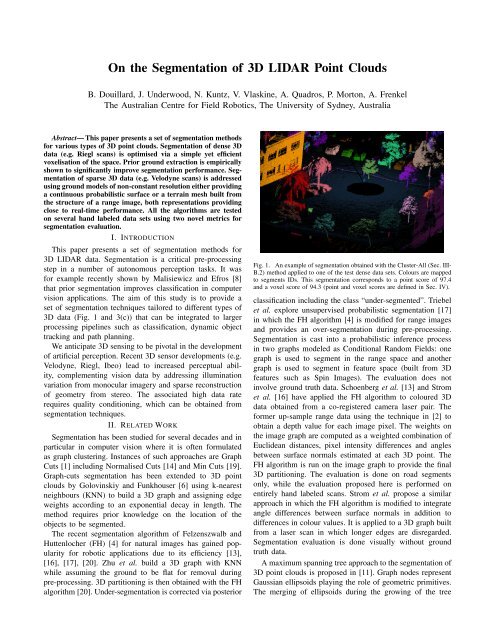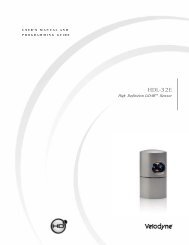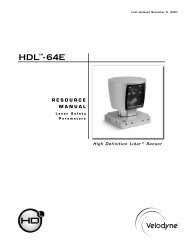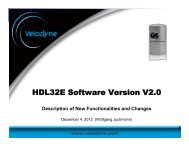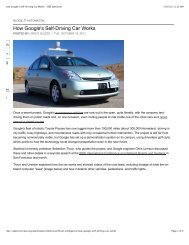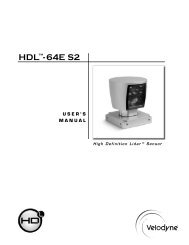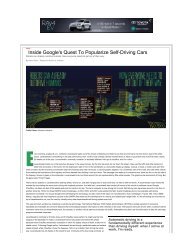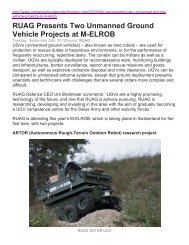On the Segmentation of 3D LIDAR Point Clouds - Velodyne Lidar
On the Segmentation of 3D LIDAR Point Clouds - Velodyne Lidar
On the Segmentation of 3D LIDAR Point Clouds - Velodyne Lidar
Create successful ePaper yourself
Turn your PDF publications into a flip-book with our unique Google optimized e-Paper software.
<strong>On</strong> <strong>the</strong> <strong>Segmentation</strong> <strong>of</strong> <strong>3D</strong> <strong>LIDAR</strong> <strong>Point</strong> <strong>Clouds</strong><br />
B. Douillard, J. Underwood, N. Kuntz, V. Vlaskine, A. Quadros, P. Morton, A. Frenkel<br />
The Australian Centre for Field Robotics, The University <strong>of</strong> Sydney, Australia<br />
Abstract— This paper presents a set <strong>of</strong> segmentation methods<br />
for various types <strong>of</strong> <strong>3D</strong> point clouds. <strong>Segmentation</strong> <strong>of</strong> dense <strong>3D</strong><br />
data (e.g. Riegl scans) is optimised via a simple yet efficient<br />
voxelisation <strong>of</strong> <strong>the</strong> space. Prior ground extraction is empirically<br />
shown to significantly improve segmentation performance. <strong>Segmentation</strong><br />
<strong>of</strong> sparse <strong>3D</strong> data (e.g. <strong>Velodyne</strong> scans) is addressed<br />
using ground models <strong>of</strong> non-constant resolution ei<strong>the</strong>r providing<br />
a continuous probabilistic surface or a terrain mesh built from<br />
<strong>the</strong> structure <strong>of</strong> a range image, both representations providing<br />
close to real-time performance. All <strong>the</strong> algorithms are tested<br />
on several hand labeled data sets using two novel metrics for<br />
segmentation evaluation.<br />
I. INTRODUCTION<br />
This paper presents a set <strong>of</strong> segmentation methods for<br />
<strong>3D</strong> <strong>LIDAR</strong> data. <strong>Segmentation</strong> is a critical pre-processing<br />
step in a number <strong>of</strong> autonomous perception tasks. It was<br />
for example recently shown by Malisiewicz and Efros [8]<br />
that prior segmentation improves classification in computer<br />
vision applications. The aim <strong>of</strong> this study is to provide a<br />
set <strong>of</strong> segmentation techniques tailored to different types <strong>of</strong><br />
<strong>3D</strong> data (Fig. 1 and 3(c)) that can be integrated to larger<br />
processing pipelines such as classification, dynamic object<br />
tracking and path planning.<br />
We anticipate <strong>3D</strong> sensing to be pivotal in <strong>the</strong> development<br />
<strong>of</strong> artificial perception. Recent <strong>3D</strong> sensor developments (e.g.<br />
<strong>Velodyne</strong>, Riegl, Ibeo) lead to increased perceptual ability,<br />
complementing vision data by addressing illumination<br />
variation from monocular imagery and sparse reconstruction<br />
<strong>of</strong> geometry from stereo. The associated high data rate<br />
requires quality conditioning, which can be obtained from<br />
segmentation techniques.<br />
II. RELATED WORK<br />
<strong>Segmentation</strong> has been studied for several decades and in<br />
particular in computer vision where it is <strong>of</strong>ten formulated<br />
as graph clustering. Instances <strong>of</strong> such approaches are Graph<br />
Cuts [1] including Normalised Cuts [14] and Min Cuts [19].<br />
Graph-cuts segmentation has been extended to <strong>3D</strong> point<br />
clouds by Golovinskiy and Funkhouser [6] using k-nearest<br />
neighbours (KNN) to build a <strong>3D</strong> graph and assigning edge<br />
weights according to an exponential decay in length. The<br />
method requires prior knowledge on <strong>the</strong> location <strong>of</strong> <strong>the</strong><br />
objects to be segmented.<br />
The recent segmentation algorithm <strong>of</strong> Felzenszwalb and<br />
Huttenlocher (FH) [4] for natural images has gained popularity<br />
for robotic applications due to its efficiency [13],<br />
[16], [17], [20]. Zhu et al. build a <strong>3D</strong> graph with KNN<br />
while assuming <strong>the</strong> ground to be flat for removal during<br />
pre-processing. <strong>3D</strong> partitioning is <strong>the</strong>n obtained with <strong>the</strong> FH<br />
algorithm [20]. Under-segmentation is corrected via posterior<br />
Fig. 1. An example <strong>of</strong> segmentation obtained with <strong>the</strong> Cluster-All (Sec. III-<br />
B.2) method applied to one <strong>of</strong> <strong>the</strong> test dense data sets. Colours are mapped<br />
to segments IDs. This segmentation corresponds to a point score <strong>of</strong> 97.4<br />
and a voxel score <strong>of</strong> 94.3 (point and voxel scores are defined in Sec. IV).<br />
classification including <strong>the</strong> class “under-segmented”. Triebel<br />
et al. explore unsupervised probabilistic segmentation [17]<br />
in which <strong>the</strong> FH algorithm [4] is modified for range images<br />
and provides an over-segmentation during pre-processing.<br />
<strong>Segmentation</strong> is cast into a probabilistic inference process<br />
in two graphs modeled as Conditional Random Fields: one<br />
graph is used to segment in <strong>the</strong> range space and ano<strong>the</strong>r<br />
graph is used to segment in feature space (built from <strong>3D</strong><br />
features such as Spin Images). The evaluation does not<br />
involve ground truth data. Schoenberg et al. [13] and Strom<br />
et al. [16] have applied <strong>the</strong> FH algorithm to coloured <strong>3D</strong><br />
data obtained from a co-registered camera laser pair. The<br />
former up-sample range data using <strong>the</strong> technique in [2] to<br />
obtain a depth value for each image pixel. The weights on<br />
<strong>the</strong> image graph are computed as a weighted combination <strong>of</strong><br />
Euclidean distances, pixel intensity differences and angles<br />
between surface normals estimated at each <strong>3D</strong> point. The<br />
FH algorithm is run on <strong>the</strong> image graph to provide <strong>the</strong> final<br />
<strong>3D</strong> partitioning. The evaluation is done on road segments<br />
only, while <strong>the</strong> evaluation proposed here is performed on<br />
entirely hand labeled scans. Strom et al. propose a similar<br />
approach in which <strong>the</strong> FH algorithm is modified to integrate<br />
angle differences between surface normals in addition to<br />
differences in colour values. It is applied to a <strong>3D</strong> graph built<br />
from a laser scan in which longer edges are disregarded.<br />
<strong>Segmentation</strong> evaluation is done visually without ground<br />
truth data.<br />
A maximum spanning tree approach to <strong>the</strong> segmentation <strong>of</strong><br />
<strong>3D</strong> point clouds is proposed in [11]. Graph nodes represent<br />
Gaussian ellipsoids playing <strong>the</strong> role <strong>of</strong> geometric primitives.<br />
The merging <strong>of</strong> ellipsoids during <strong>the</strong> growing <strong>of</strong> <strong>the</strong> tree
is based on one <strong>of</strong> <strong>the</strong> two distance metrics proposed by<br />
<strong>the</strong> authors, each producing a different segmentation “style”.<br />
The resulting segmentation is similar to a super voxel type<br />
<strong>of</strong> partitioning (by analogy to super pixels in vision) with<br />
voxels <strong>of</strong> ellipsoidal shapes and various sizes.<br />
Various methods focus on explicitly modeling <strong>the</strong> notion<br />
<strong>of</strong> surface discontinuity. Melkumyan defines discontinuities<br />
based on acute angles and longer links in a <strong>3D</strong> mesh built<br />
from range data [9]. Moosman et al. use <strong>the</strong> notion <strong>of</strong> convexity<br />
in a terrain mesh as a separator between objects [10].<br />
The latter approach is compared to <strong>the</strong> proposed algorithms<br />
in Sec. V-B.<br />
The contribution <strong>of</strong> this work is multi-fold: a set <strong>of</strong> segmentation<br />
algorithms are proposed for various data densities,<br />
which nei<strong>the</strong>r assume <strong>the</strong> ground to be flat nor require a prior<br />
knowledge <strong>of</strong> <strong>the</strong> location <strong>of</strong> <strong>the</strong> objects to be segmented.<br />
The ground is explicitly identified using various techniques<br />
depending on <strong>the</strong> data type and used as a separator. Some <strong>of</strong><br />
<strong>the</strong> proposed techniques are close to real-time and capable<br />
<strong>of</strong> processing any source <strong>of</strong> <strong>3D</strong> data (Sec. III-C.1) or are<br />
optimised by exploiting <strong>the</strong> structure <strong>of</strong> <strong>the</strong> scanning pattern<br />
(Sec. III-C.2). All <strong>the</strong> methods are evaluated on hand labeled<br />
data using two novel metrics for segmentation comparison<br />
(Sec. V).<br />
III. SEGMENTATION ALGORITHMS<br />
A. Framework<br />
This study considers <strong>the</strong> following three aspects <strong>of</strong> <strong>the</strong> segmentation<br />
problem. First, it investigates various types <strong>of</strong> <strong>3D</strong><br />
data: from dense (<strong>3D</strong> scans from a Riegl sensor for instance)<br />
to sparse (single <strong>Velodyne</strong> scans). Second, different types <strong>of</strong><br />
model are used to represent and segment <strong>the</strong> ground. Three<br />
main types <strong>of</strong> ground models are explored: grid based (as in<br />
standard elevation maps [15], Sec. III-B), Gaussian Process<br />
based (Sec. III-C.1) and mesh based (Sec. III-C.2). Third,<br />
several types <strong>of</strong> <strong>3D</strong> clustering techniques are tested and in<br />
particular <strong>3D</strong> grid based segmentation with various cluster<br />
connectivity criteria is evaluated. The resulting algorithms<br />
are compositions <strong>of</strong> a ground model and a <strong>3D</strong> clustering<br />
method. This study evaluates which algorithm provides better<br />
segmentation performance for each data type.<br />
The notions <strong>of</strong> dense and sparse data are here defined<br />
based on a discretisation <strong>of</strong> <strong>the</strong> world with a constant<br />
resolution. A data set will be considered to be dense if <strong>the</strong><br />
connectivity <strong>of</strong> most scanned surfaces can be captured with<br />
<strong>the</strong> connectivity <strong>of</strong> non-empty cells (cells receiving at least<br />
one data point). With sparser data, <strong>the</strong> number <strong>of</strong> empty cells<br />
increases which causes objects to be over-segmented. The<br />
algorithms proposed to segment dense data involve constant<br />
resolution grid-based models, while <strong>the</strong> algorithms proposed<br />
to process sparse data use ground representations which are<br />
<strong>of</strong> non-constant granularity and implement various types <strong>of</strong><br />
interpolation mechanism as a way to bridge <strong>the</strong> holes in <strong>the</strong><br />
data.<br />
B. <strong>Segmentation</strong> for Dense Data<br />
The general approach used for dense data is a voxel grid<br />
based segmentation. A three dimensional cubic voxel grid<br />
is populated with <strong>3D</strong> points and features are computed in<br />
each voxel. Features include <strong>3D</strong> means and variances as well<br />
as density. This voxel grid approach is chosen due to its<br />
simplicity, ease <strong>of</strong> representation both visually and in data<br />
structures, and its ability to be scaled by adjusting voxel size<br />
to insure usable density <strong>of</strong> data in <strong>the</strong> voxels.<br />
For dense data segmentation four different variations on<br />
this method are used, three <strong>of</strong> which have two stages and<br />
one which is single stage. The extra stage in <strong>the</strong> two stage<br />
processes is <strong>the</strong> determination <strong>of</strong> <strong>the</strong> ground partition, <strong>the</strong><br />
common stage is a <strong>3D</strong> clustering process. For all methods,<br />
voxels must meet minimum density requirements to be<br />
considered for segmentation.<br />
1) Ground <strong>Segmentation</strong>: The ground partition is found<br />
by clustering toge<strong>the</strong>r adjacent voxels based on vertical<br />
means and variances. If <strong>the</strong> difference between means is less<br />
than a given threshold, and <strong>the</strong> difference between variances<br />
is less than a separate threshold, <strong>the</strong> voxels are grouped.<br />
The largest partition found by this method is chosen as <strong>the</strong><br />
ground.<br />
2) Cluster-All Method: Ground segmentation is performed<br />
and <strong>the</strong> remaining non-ground points are partitioned<br />
by local voxel adjacency only. The size <strong>of</strong> <strong>the</strong> local neighbourhood<br />
is <strong>the</strong> only parameter. The ground is <strong>the</strong>refore<br />
operating as a separator between <strong>the</strong> partitions. The general<br />
outline <strong>of</strong> this method is shown in Algorithm 1. An example<br />
<strong>of</strong> segmentation it produces is shown in Fig. 1.<br />
Input : pCloud<br />
Output : ground, voxelclusters<br />
Parameters: res, method<br />
1 voxelgrid ← FillVoxelGrid(pCloud,res) ;<br />
2 ground ← ExtractGround(voxelgrid) ;<br />
3 voxelgrid ← ResetVoxels(voxelgrid, ground) ;<br />
4 voxelclusters ← SegmentVoxelGrid(voxelgrid,method) ;<br />
Algorithm 1: The Dense Data <strong>Segmentation</strong> Pipeline, With Ground<br />
Extraction<br />
3) Base-Of Method: In order to test <strong>the</strong> benefit <strong>of</strong> using<br />
<strong>the</strong> ground as a separator between objects, a technique which<br />
does not rely <strong>of</strong> <strong>the</strong> extraction <strong>of</strong> a ground surface is also<br />
defined. The algorithm considers voxels to be ei<strong>the</strong>r flat<br />
or non-flat depending on vertical variance. Flat voxels are<br />
grouped toge<strong>the</strong>r, as are non-flat voxels. Dissimilar voxels<br />
are grouped only if <strong>the</strong> non-flat voxel is below <strong>the</strong> flat voxel.<br />
This last criteria is based on <strong>the</strong> idea that sections <strong>of</strong> an object<br />
are generally stacked on top <strong>of</strong> one ano<strong>the</strong>r because <strong>of</strong> <strong>the</strong><br />
influence <strong>of</strong> gravity, hence some voxels are <strong>the</strong> base <strong>of</strong> o<strong>the</strong>r<br />
voxels from <strong>the</strong> ground up. A typical example observed in<br />
<strong>the</strong> data is <strong>the</strong> ro<strong>of</strong> <strong>of</strong> a car, which may be disconnected<br />
from to <strong>the</strong> rest <strong>of</strong> <strong>the</strong> car’s body without <strong>the</strong> ‘base-<strong>of</strong>’<br />
relationship. In this case, flat voxels forming <strong>the</strong> ro<strong>of</strong> <strong>of</strong> <strong>the</strong><br />
car are connected and non-flat voxels forming <strong>the</strong> body <strong>of</strong> <strong>the</strong><br />
car are also connected, resulting in two partitions. Applying<br />
<strong>the</strong> base-<strong>of</strong> relationship, <strong>the</strong> body <strong>of</strong> <strong>the</strong> car is interpreted as<br />
<strong>the</strong> base <strong>of</strong> its ro<strong>of</strong> and <strong>the</strong> full car is connected into a single<br />
segment.<br />
4) Base-Of With Ground Method: Ground segmentation<br />
is performed and <strong>the</strong>n <strong>the</strong> Base-Of method is applied to <strong>the</strong><br />
remaining non-ground voxels.
C. <strong>Segmentation</strong> for Sparse Data<br />
Two complementary segmentation methods for sparse data<br />
are presented; Gaussian Process Incremental Sample Consensus<br />
(GP-INSAC) and Mesh Based <strong>Segmentation</strong>. These<br />
methods provide a sparse version <strong>of</strong> ExtractGround,<br />
followed by <strong>the</strong> use <strong>of</strong> <strong>the</strong> Cluster-All approach from Section<br />
III-B. The GP-INSAC method is designed to operate on<br />
arbitrary <strong>3D</strong> point clouds in a common cartesian reference<br />
frame. This provides <strong>the</strong> flexibility to process any source <strong>of</strong><br />
<strong>3D</strong> data, including multiple <strong>3D</strong> data sources that have been<br />
fused in a common frame. By leveraging <strong>the</strong> sensor scanning<br />
pattern, <strong>the</strong> Mesh Based method is optimised for <strong>3D</strong> point<br />
cloud data in a single sensor frame. This provides additional<br />
speed or accuracy for particular sensor types.<br />
1) Gaussian Process Incremental Sample Consensus (GP-<br />
INSAC): The Gaussian Process Incremental Sample Consensus<br />
(GP-INSAC) algorithm is an iterative approach to probabilistic,<br />
continuous ground surface estimation, for sparse <strong>3D</strong><br />
data sets that are cluttered by non-ground objects. The use <strong>of</strong><br />
Gaussian Process (GP) methods to model sparse terrain data<br />
was explored in [18]. These methods have three properties<br />
that are useful for segmentation: (1) <strong>the</strong>y operate on sparse<br />
data, (2) <strong>the</strong>y are probabilistic, so decision boundaries for<br />
segmentation can be specified rigorously, (3) <strong>the</strong>y are continuous,<br />
avoiding some <strong>of</strong> <strong>the</strong> grid constraints in <strong>the</strong> dense<br />
methods. However, GP methods typically assume that most<br />
<strong>of</strong> <strong>the</strong> data pertain to <strong>the</strong> terrain surface and not to objects<br />
or clutter; i.e. <strong>the</strong>y assume <strong>the</strong>re are few outliers. Here,<br />
<strong>the</strong> problem is re-formulated as one <strong>of</strong> model based outlier<br />
rejection, where inliers are points that belong to <strong>the</strong> ground<br />
surface and outliers belong to cluttered non-surface objects,<br />
that will ultimately be segmented. The GP-INSAC algorithm<br />
maintains <strong>the</strong> properties <strong>of</strong> GP terrain modeling techniques<br />
and endows <strong>the</strong>m with an outlier rejection capability.<br />
A common approach to outlier rejection is <strong>the</strong> Random<br />
Sample Consensus (RANSAC) algorithm [5], [12]. As <strong>the</strong><br />
complexity <strong>of</strong> <strong>the</strong> model increases, so does <strong>the</strong> number<br />
<strong>of</strong> hypo<strong>the</strong>tical inliers required to specify it, causing <strong>the</strong><br />
computational performance <strong>of</strong> RANSAC to decrease. For<br />
complex models including GPs, an alternate approach is<br />
presented, called Incremental Sample Consensus. Although<br />
motivated by <strong>the</strong> cases where RANSAC is not practical,<br />
INSAC is not a variant <strong>of</strong> RANSAC as in [12]. Deterministic<br />
iterations are performed to progressively fit <strong>the</strong> model from<br />
a single seed <strong>of</strong> high probability inliers, ra<strong>the</strong>r than iterating<br />
solutions over randomly selected seeds.<br />
The INSAC method is specified by Algorithm 2. Starting<br />
with a set <strong>of</strong> data and an a-priori seed subset <strong>of</strong> high<br />
confidence inliers, <strong>the</strong> INSAC algorithm fits a model to<br />
<strong>the</strong> seed, <strong>the</strong>n evaluates this for <strong>the</strong> remaining data points<br />
(similar to <strong>the</strong> first iteration <strong>of</strong> RANSAC). All <strong>of</strong> <strong>the</strong> noninlier<br />
points are compared with this model (using Eval from<br />
Algorithm 2). INSAC uses probabilistic models that estimate<br />
<strong>the</strong> uncertainty <strong>of</strong> <strong>the</strong>ir predictions, leading to two thresholds:<br />
t model specifies how certain <strong>the</strong> model must be for in/outlier<br />
determination to proceed. Subsequently, t data specifies <strong>the</strong><br />
Input : data, modelT ype, i seed<br />
Output : i, o, u, model<br />
Parameters: t data , t model<br />
1 i = o = u = {};<br />
2 i new = i seed ;<br />
3 while size(i new) > 0 do<br />
4 i = i ∪ i new;<br />
5 model = Fit(modelT ype, i);<br />
6 test = data − i;<br />
7 {i new, o new, u new} = Eval (model, test, t data , t model );<br />
8 o = o ∪ o new;<br />
9 u = u ∪ u new;<br />
10 end<br />
Algorithm 2: The Incremental Sample Consensus (INSAC) Algorithm.<br />
For brevity, i,o,u and t represent inliers, outliers, unknown and<br />
threshold respectively.<br />
normalised proximity <strong>of</strong> a datum (x) to <strong>the</strong> model prediction<br />
(µ model ), required for <strong>the</strong> datum to be considered an inlier.<br />
This is done using a variant <strong>of</strong> <strong>the</strong> Mahalanobis distance to<br />
normalise <strong>the</strong> measure, given estimates <strong>of</strong> <strong>the</strong> noise in <strong>the</strong><br />
data and in <strong>the</strong> model (σ data , σ model , respectively). The two<br />
rules are expressed by:<br />
σ model < t model<br />
and<br />
x − µ model<br />
√ < t data (1)<br />
σ<br />
2 x + σmodel<br />
2<br />
If <strong>the</strong> first inequality fails, a point is classified unknown.<br />
<strong>Point</strong>s that pass <strong>the</strong> first inequality are classified inliers if <strong>the</strong>y<br />
also pass <strong>the</strong> second inequality, o<strong>the</strong>rwise <strong>the</strong>y are outliers.<br />
Starting from <strong>the</strong> seed, inliers are accumulated per iteration.<br />
This allows INSAC to ’search’ <strong>the</strong> data to find inliers,<br />
without allowing unknown points to corrupt <strong>the</strong> model.<br />
Iterations are performed until no more inliers are found. The<br />
process combines both extrapolation and interpolation <strong>of</strong> <strong>the</strong><br />
model, but only in regions where <strong>the</strong> certainty is sufficiently<br />
high. This can be seen in <strong>the</strong> sequence <strong>of</strong> iterations <strong>of</strong> GP-<br />
INSAC in Figure 2. The first iteration extrapolates but misses<br />
a point because <strong>the</strong> data uncertainty is too large. By <strong>the</strong> third<br />
iteration, it has captured this point using interpolation, once<br />
<strong>the</strong> model/data agreement is more likely. Like RANSAC,<br />
this method can be used with any core model, however <strong>the</strong><br />
justification to do so is strongest for complex probabilistic<br />
models such as GPs.<br />
The customisation <strong>of</strong> <strong>the</strong> INSAC algorithm for terrain<br />
estimation using GPs is given in Algorithm 3. The algorithm<br />
comprises four key steps; data compression, seed calculation,<br />
INSAC and data decompression. Figure 2 shows three<br />
iterations <strong>of</strong> <strong>the</strong> basic algorithm for simulated 2D data, to<br />
illustrate <strong>the</strong> process, not including compression.<br />
Input : x = {x i , y i , z i }, i = [0, N];<br />
Output : i, o, u, model<br />
Parameters: t data , t model , GP, r, d, R s, B s<br />
1 x gm = GridMeanCompress(x,r);<br />
2 x dgm = Decimate(x gm,d);<br />
3 s dgm = Seed(x dgm ,R s,B s);<br />
4 {, , , gp dgm } = INSAC(GP , s dgm , t data , t model );<br />
5 {i gm, o gm, u gm} =Eval(gp dgm , x gm, t data , t model );<br />
6 {i, o, u} = GridMeanDecompress(x, i gm, o gm, u gm);<br />
7 model = gp dgm ;<br />
Algorithm 3: The Gaussian Process INSAC (GP-INSAC) Algorithm<br />
for Terrain Estimation, with optional Data Compression. i,o,u and t<br />
represent inliers, outliers, unknown and threshold respectively.<br />
The ability <strong>of</strong> GP models to handle sparse data allows<br />
an optional step <strong>of</strong> compressing <strong>the</strong> data, to decrease <strong>the</strong>
(a) (b) (c)<br />
Fig. 2. The GP-INSAC method from Algorithm 3 is run on simulated 2D data. A ground seed is chosen manually, shown in green. The output after <strong>the</strong><br />
first iteration is shown in (a), after three iterations in (b) and <strong>the</strong> 16th and final iteration in (c)<br />
computation time. Compression is performed in two stages<br />
in lines 1 and 2 <strong>of</strong> Algorithm 3. The data are first assigned<br />
to a fixed <strong>3D</strong> grid structure with a constant cell size <strong>of</strong> r<br />
metres. In each cell, <strong>the</strong> contents are represented by <strong>the</strong>ir <strong>3D</strong><br />
mean. In <strong>the</strong> second stage, <strong>the</strong> data are decimated by keeping<br />
1 in every d <strong>of</strong> <strong>the</strong> grid means. The first stage compresses<br />
<strong>the</strong> data towards uniform density, avoiding grid quantisation<br />
errors by calculating <strong>the</strong> means. The second stage allows<br />
fur<strong>the</strong>r compression, without requiring larger (less accurate)<br />
cell sizes.<br />
<strong>On</strong>ce <strong>the</strong> optional compression is performed, an initial<br />
seed <strong>of</strong> likely ground points is determined using <strong>the</strong> application<br />
specific Seed function. For this study, <strong>the</strong> points<br />
within a fixed radius R s <strong>of</strong> <strong>the</strong> sensor that are also below<br />
<strong>the</strong> base height B s <strong>of</strong> <strong>the</strong> sensor are chosen (|x| < R s<br />
and x z < B s ), assuming this region is locally uncluttered<br />
by non-ground objects. INSAC is <strong>the</strong>n performed as per<br />
Algorithm 2, on <strong>the</strong> decimated grid means. This classifies<br />
<strong>the</strong> decimated grid mean data into <strong>the</strong> three classes; inliers,<br />
outliers or unknown and provides <strong>the</strong> GP model representing<br />
<strong>the</strong> continuous ground surface according to <strong>the</strong> inliers.<br />
The data are <strong>the</strong>n decompressed in lines 5 and 6 <strong>of</strong><br />
Algorithm 3. The GP model (from <strong>the</strong> decimated means)<br />
is used to classify all <strong>of</strong> <strong>the</strong> un-decimated means, using<br />
<strong>the</strong> same function from <strong>the</strong> INSAC method in line 7 <strong>of</strong><br />
Algorithm 2 and Equation III-C.1. Finally, <strong>the</strong> class <strong>of</strong> <strong>the</strong><br />
grid means is applied to <strong>the</strong> full input data by cell correspondence,<br />
using GridMeanDecompress. The output is <strong>the</strong><br />
full classification <strong>of</strong> <strong>the</strong> original data, as inliers (belonging<br />
to <strong>the</strong> ground), outliers (belonging to an object) or unknown<br />
(could not be classified with high certainty).<br />
For sparse segmentation, <strong>the</strong> ground data produced<br />
by GP-INSAC in Algorithm 3 are considered as one<br />
partition. The non-ground data are <strong>the</strong>n processed by<br />
SegmentVoxelGrid with <strong>the</strong> Cluster-All method from<br />
Section III-B.2 to produce <strong>the</strong> remaining non-ground partitions.<br />
Unknown points remain classified as such.<br />
In Section V, <strong>the</strong> performance <strong>of</strong> <strong>the</strong> algorithm is demonstrated<br />
with different parameter values and optimal parameter<br />
choices are given by comparison with hand partitioned data.<br />
2) Mesh Based <strong>Segmentation</strong>: The Mesh Based <strong>Segmentation</strong><br />
algorithm involves three main steps: (1) construction<br />
<strong>of</strong> a terrain mesh from a range image; (2) extraction <strong>of</strong> <strong>the</strong><br />
ground points based on <strong>the</strong> computation <strong>of</strong> a gradient field<br />
in <strong>the</strong> terrain mesh; (3) clustering <strong>of</strong> <strong>the</strong> non-ground points<br />
using <strong>the</strong> Cluster-All method.<br />
The generation <strong>of</strong> a mesh from a range image follows <strong>the</strong><br />
approach in [10], which exploits <strong>the</strong> raster scan arrangement<br />
for fast topology definition (around 10 ms per scan). An<br />
example <strong>of</strong> <strong>the</strong> resulting mesh is shown in Fig. 3(a). With<br />
sparse data, such a mesh creates a point-to-point connectivity<br />
which could not be captured with a constant resolution grid.<br />
As a consequence <strong>the</strong> ground partition can be grown from<br />
a seed region (here, <strong>the</strong> origin <strong>of</strong> <strong>the</strong> scan) through <strong>the</strong><br />
connected topology.<br />
<strong>On</strong>ce <strong>the</strong> terrain mesh is built, <strong>the</strong> segmenter extracts<br />
<strong>the</strong> ground (function ExtractGround in algorithm 1) by<br />
computing a gradient field in <strong>the</strong> mesh. For each node (i.e.<br />
laser return), <strong>the</strong> gradient <strong>of</strong> every incoming edge is first<br />
evaluated. The gradient value for <strong>the</strong> node is chosen as <strong>the</strong><br />
one with <strong>the</strong> maximum norm. The four links around a given<br />
node are identified as: {UP, DOWN, LEFT, RIGHT}, with<br />
DOWN pointing toward <strong>the</strong> origin <strong>of</strong> <strong>the</strong> scan. To compute<br />
<strong>the</strong> gradient on <strong>the</strong> DOWN edge, for instance, <strong>the</strong> algorithm<br />
traverses <strong>the</strong> mesh from one node to <strong>the</strong> following in <strong>the</strong><br />
DOWN direction until a distance <strong>of</strong> mingraddist is covered.<br />
The gradient is <strong>the</strong>n obtained as <strong>the</strong> absolute difference <strong>of</strong> <strong>the</strong><br />
height <strong>of</strong> <strong>the</strong> starting and ending node divided by <strong>the</strong> distance<br />
between <strong>the</strong>m. If a mingraddist length is not covered in<br />
a given direction, <strong>the</strong> gradient is disregarded. Enforcing a<br />
minimum gradient support length allows noise to be averaged<br />
out: as can be seen in Fig. 3(a), <strong>the</strong> nodes nearer to <strong>the</strong> centre<br />
<strong>of</strong> <strong>the</strong> scan are nearer to each o<strong>the</strong>r, which generates noisy<br />
gradient estimates if consecutive nodes are used to calculate<br />
<strong>the</strong> gradients (since <strong>the</strong> noise in <strong>the</strong>ir height values is <strong>of</strong> <strong>the</strong><br />
same magnitude as <strong>the</strong> length <strong>of</strong> <strong>the</strong> links connecting <strong>the</strong>m).<br />
<strong>On</strong>ce <strong>the</strong> gradient field is computed, <strong>the</strong> ground partition<br />
is obtained by growing a cluster <strong>of</strong> ground nodes from <strong>the</strong><br />
closest to <strong>the</strong> fur<strong>the</strong>st raster line. In <strong>the</strong> closest raster line<br />
(<strong>the</strong> inner most ring in Fig. 3(a)), <strong>the</strong> label GROUND is<br />
assigned to <strong>the</strong> longest sequence <strong>of</strong> nodes s g with gradients<br />
below maxgrad. Additionally, sequences <strong>of</strong> nodes s i from<br />
<strong>the</strong> inner ring with gradients below <strong>the</strong> threshold maxgrad<br />
are also marked GROUND if, given that n i and n g are<br />
<strong>the</strong> closest nodes in s i and s g , respectively, <strong>the</strong>ir height<br />
is within maxdh. For <strong>the</strong> o<strong>the</strong>r raster lines, a node is<br />
marked as GROUND if its gradient value is below maxgrad,<br />
and it has at least one <strong>of</strong> its direct neighbours already<br />
identified as GROUND; whe<strong>the</strong>r this neighbour is in <strong>the</strong><br />
same raster line or in <strong>the</strong> previous one. This last requirement<br />
encodes <strong>the</strong> iterative growing <strong>of</strong> <strong>the</strong> ground partition and<br />
avoids non-ground flat partitions (such as <strong>the</strong> ro<strong>of</strong> <strong>of</strong> a<br />
car) to be mistaken as part <strong>of</strong> <strong>the</strong> ground. This propagation<br />
process assumes that <strong>the</strong> ground can be observed around <strong>the</strong><br />
sensor; more specifically, it assumes that at least part <strong>of</strong> <strong>the</strong><br />
raster line nearest <strong>the</strong> sensor falls on <strong>the</strong> ground, and <strong>the</strong><br />
corresponding set <strong>of</strong> nodes form <strong>the</strong> longest flat sequence.<br />
The propagation <strong>of</strong> <strong>the</strong> GROUND label is performed in both
(a) (b) (c)<br />
Fig. 3. (a) The mesh built from <strong>the</strong> range image; points (nodes) identified as belonging to <strong>the</strong> ground are in white; o<strong>the</strong>r colours indicate <strong>of</strong>f <strong>the</strong> ground<br />
segments. (b) An example <strong>of</strong> transition detection around a car in <strong>the</strong> terrain mesh: ground points are in blue, non ground points in green, and transition<br />
points in red. (c) An example <strong>of</strong> full segmentation obtained with <strong>the</strong> combination {Mesh Based segmenter, Cluster-All}. <strong>On</strong>e colour corresponds to one<br />
segment.<br />
directions in each scan line (i.e. each scan line is traversed<br />
twice) since intercepting objects may stop <strong>the</strong> propagation.<br />
The extraction <strong>of</strong> <strong>the</strong> ground is illustrated in Fig. 3(c).<br />
The last step in <strong>the</strong> extraction <strong>of</strong> <strong>the</strong> ground is <strong>the</strong><br />
identification <strong>of</strong> <strong>the</strong> transitions between <strong>the</strong> ground and <strong>the</strong><br />
objects above. The need for transition detection is developed<br />
in [3] (Fig. 5). Its effect is illustrated in Fig. 3(b). Transitions<br />
are detected by maintaining a buffer <strong>of</strong> consecutive<br />
GROUND node heights (up to ten values are buffered in our<br />
implementation). This buffer is slid along each raster line<br />
first, and <strong>the</strong>n along each radial line, while GROUND node<br />
heights are added in a First In First Out fashion. The buffer<br />
is emptied when starting <strong>the</strong> processing <strong>of</strong> <strong>the</strong> next line. A<br />
node is marked as TRANSITION if it does not belong to <strong>the</strong><br />
ground based on its gradient but its height is within maxdh<br />
<strong>of</strong> <strong>the</strong> buffer mean height. The buffer is slid twice on each<br />
scan and radial line; once in each direction along <strong>the</strong> line in<br />
order to identify <strong>the</strong> transitions on all sides <strong>of</strong> an object. As<br />
illustrated in Fig. 3(b), transition detection allows a tighter<br />
segmentation <strong>of</strong> objects which is essential in cluttered areas.<br />
<strong>On</strong>ce <strong>the</strong> ground is extracted, <strong>the</strong> NON-GROUND points<br />
are fed to a voxel grid and a Cluster-All segmentation is<br />
applied. Note that <strong>the</strong> points identified as TRANSITION are<br />
not passed to <strong>the</strong> <strong>3D</strong> segmenter since this allows a tighter<br />
segmentation <strong>of</strong> objects. This completes <strong>the</strong> segmentation<br />
process as implemented by <strong>the</strong> Mesh Based Segmenter.<br />
Its output is illustrated in Fig. 3(c). In <strong>the</strong> experiments<br />
(Sec. V-B), <strong>the</strong> three parameters mingraddist, maxdh and<br />
maxgrad are optimised based on hand-labeled segmentations.<br />
IV. METRIC FOR SEGMENTATION EVALUATION<br />
A metric is proposed to quantify <strong>the</strong> agreement between<br />
two segmentations <strong>of</strong> <strong>the</strong> same set <strong>of</strong> data. This can be<br />
used to quantify <strong>the</strong> performance <strong>of</strong> different segmentation<br />
algorithms, by comparison to a hand segmented scene. The<br />
general concept <strong>of</strong> <strong>the</strong> metric is illustrated in Fig. 4. The tree<br />
marked B is <strong>the</strong> manual segmentation and <strong>the</strong> tree marked A<br />
is an example <strong>of</strong> flawed segmentation. The largest segment<br />
<strong>of</strong> <strong>the</strong> voxels in A that comprises <strong>the</strong> tree is considered <strong>the</strong><br />
match, in this case <strong>the</strong> red area <strong>of</strong> <strong>the</strong> tree top, and all o<strong>the</strong>r<br />
partitions are considered errors. <strong>On</strong>ce a segment has been<br />
considered as a match, it will be considered as an error in<br />
any subsequent match attempts.<br />
The specific comparison process is as follows. First <strong>the</strong><br />
partitions <strong>of</strong> <strong>the</strong> hand-picked data are sorted from largest<br />
Fig. 4.<br />
Example <strong>of</strong> <strong>Segmentation</strong> Comparison<br />
to smallest. For each reference partition, each data point is<br />
matched to <strong>the</strong> same point in <strong>the</strong> test segmentation. A list <strong>of</strong><br />
partition sizes is accumulated based on <strong>the</strong> partition IDs <strong>of</strong><br />
<strong>the</strong> points. The largest partition <strong>of</strong> test points that correspond<br />
to <strong>the</strong> given hand-picked partition is <strong>the</strong>n considered to be a<br />
match. The partition ID that is considered matching is <strong>the</strong>n<br />
marked as used and <strong>the</strong>n when any o<strong>the</strong>r points with that<br />
ID are found <strong>the</strong>y are considered to be in error. Because <strong>the</strong><br />
comparison is performed in order from <strong>the</strong> largest partition<br />
to <strong>the</strong> smallest, if a small object is incorrectly grouped to<br />
a large object, <strong>the</strong> smaller object will be considered to be<br />
erroneously partitioned and not <strong>the</strong> larger object. From <strong>the</strong><br />
points marked as matches and those marked as errors, a<br />
percentage match is calculated.<br />
Alternative metrics are also considered. In particular, scoring<br />
in terms <strong>of</strong> voxels instead <strong>of</strong> points. Since all points in a<br />
voxel must have <strong>the</strong> same partition ID, voxels can be marked<br />
as matched or errors when <strong>the</strong> status <strong>of</strong> any point within<br />
<strong>the</strong> voxel is determined. Then <strong>the</strong> voxel match percentage<br />
is also calculated. The voxel match percentage tends to be<br />
more volatile than <strong>the</strong> point match percentage. The quality<br />
<strong>of</strong> partitioning <strong>of</strong> smaller, sparser, more difficult to partition<br />
objects is usually better represented by <strong>the</strong> voxel score due<br />
to less domination by ground and wall points. For example,<br />
in one <strong>of</strong> <strong>the</strong> data sets used here, <strong>the</strong> ground comprises<br />
over 700,000 points <strong>of</strong> <strong>the</strong> 1.6 million points in <strong>the</strong> scan<br />
(44%), but only 35,600 voxels <strong>of</strong> <strong>the</strong> 143,000 voxels in <strong>the</strong><br />
segmentation (24%).<br />
V. EXPERIMENTS<br />
This empirical analysis follows <strong>the</strong> principles laid out<br />
by Hoover et al. in <strong>the</strong>ir reference work on experimental<br />
evaluations <strong>of</strong> segmentation methods for range images [7]. In<br />
particular, <strong>the</strong> parameter space <strong>of</strong> each algorithm is uniformly<br />
sampled to find <strong>the</strong> combination <strong>of</strong> parameters providing<br />
<strong>the</strong> best segmentation results with respect to several hand<br />
labeled data sets (<strong>the</strong> use <strong>of</strong> more sophisticated optimisers<br />
is left for future work). Match percentages (relative to <strong>the</strong><br />
hand segmented data) and computation times are recorded<br />
and averaged over <strong>the</strong> test data sets for each combination
<strong>of</strong> parameters tested. The best results for dense and sparse<br />
data are provided in Tables I and II, respectively. The best<br />
results across methods are indicated in bold. The type <strong>of</strong><br />
implementation used is also indicated. The output <strong>of</strong> each<br />
technique is fur<strong>the</strong>r illustrated in <strong>the</strong> video associated with<br />
this submission (a longer version <strong>of</strong> this video is available at:<br />
http://www.acfr.usyd.edu.au/afmr/segmentation/icra11results.wmv).<br />
A. Dense Data Results<br />
Four hand labeled data sets (with point-wise labels) are<br />
used in this first set <strong>of</strong> experiments: two are formed from a<br />
single Riegl scan, one acquired at Drexel University, US,<br />
and a second one at <strong>the</strong> University <strong>of</strong> Sydney, Australia<br />
(Fig. 1); ano<strong>the</strong>r set is generated by combining vertical<br />
scans from a SICK laser with <strong>the</strong> navigation solution <strong>of</strong> <strong>the</strong><br />
mobile platform <strong>the</strong> sensor is mounted on; and a fourth set is<br />
obtained by combining <strong>Velodyne</strong> scans and navigation data.<br />
The four point clouds were acquired in static environments.<br />
1) Cluster-All <strong>Segmentation</strong> Method: For this experiment,<br />
<strong>the</strong> role <strong>of</strong> voxels size was tested. The two plots in Fig. 5 are<br />
<strong>the</strong> point and voxel scores versus voxel size in centimeters<br />
and neighbourhood. The neighbourhood value is <strong>the</strong> absolute<br />
magnitude <strong>of</strong> <strong>the</strong> distance two voxels can be away from each<br />
o<strong>the</strong>r, in terms <strong>of</strong> voxel grid spaces. For example two voxels<br />
that are touching but one grid <strong>of</strong>f in x or y would have a<br />
magnitude <strong>of</strong> 1, and if <strong>the</strong> voxels were only touching corner<br />
to corner that would be a magnitude <strong>of</strong> 3. The voxel size<br />
tests show a peak at 0.2m. In terms <strong>of</strong> computation times,<br />
at a voxel sizes <strong>of</strong> 0.1m, 0.2m, and 0.4m processing took<br />
on average 8.02s, 4.30s, and 3.82s respectively (<strong>the</strong>se times<br />
cannot be directly compared to <strong>the</strong> o<strong>the</strong>r tests because a<br />
different data structure was used to allow a larger number <strong>of</strong><br />
voxels to be represented). The peak match percentage occurs<br />
with a voxel size <strong>of</strong> 0.2m. Since a significant time penalty<br />
is incurred for smaller voxels and minimal time savings are<br />
achieved with larger voxels, <strong>the</strong> conclusion can be made that<br />
0.2m is optimal based on <strong>the</strong>se tests. The scores reported in<br />
Table I correspond to this parameter choice.<br />
Fig. 5. Cluster-All <strong>Segmentation</strong>, Scores <strong>of</strong> Variance Tests and Voxel Size<br />
Tests.<br />
A variant <strong>of</strong> Cluster-All involving a varying neighbourhood<br />
size was also tested. It is illustrated in Fig. 7(a). The<br />
density <strong>of</strong> objects and <strong>the</strong> density <strong>of</strong> scan points is greater at<br />
lower heights above ground due to objects naturally resting<br />
on <strong>the</strong> ground and <strong>the</strong> corresponding proximity <strong>of</strong> <strong>the</strong> sensor.<br />
Employing larger neighbourhoods a certain distance above<br />
<strong>the</strong> ground can prevent over-segmentation <strong>of</strong> high sparse<br />
objects while not risking under-segmentation <strong>of</strong> objects close<br />
toge<strong>the</strong>r on <strong>the</strong> ground. The corresponding results are reported<br />
in <strong>the</strong> line ‘Cluster-All with Variable Neighbourhood’<br />
Fig. 6. Base-Of <strong>Segmentation</strong>, Match Results vs Standard Deviation and<br />
<strong>3D</strong> Neighbourhood.<br />
<strong>of</strong> table I. In <strong>the</strong>se tests <strong>the</strong> neighbourhood was restricted to 3<br />
for voxels less than 2 meters above <strong>the</strong> ground and extended<br />
to 6 o<strong>the</strong>rwise.<br />
2) Base-Of <strong>Segmentation</strong> Method: For this method two<br />
parameters were varied and all tests were run both with<br />
and without <strong>the</strong> ExtractGround operation (Algorithm 1).<br />
Fig. 6 shows <strong>3D</strong> plots <strong>of</strong> <strong>the</strong> average results for <strong>the</strong> four<br />
dense data sets. While Base-Of without ground extraction<br />
has <strong>the</strong> advantage <strong>of</strong> being almost twice as fast as <strong>the</strong> ground<br />
based methods, it is behind <strong>the</strong> o<strong>the</strong>r techniques in terms <strong>of</strong><br />
accuracy. This result experimentally confirms <strong>the</strong> usefulness<br />
<strong>of</strong> explicit ground extraction in <strong>3D</strong> segmentation.<br />
B. Sparse Data Results<br />
Four hand labeled <strong>Velodyne</strong> scans (with point-wise labels)<br />
are used for <strong>the</strong> evaluation <strong>of</strong> <strong>the</strong> sparse methods. The results<br />
are presented in Table II and were obtained by averaging<br />
performance and computation times over <strong>the</strong> four labeled<br />
scans (<strong>the</strong> same as <strong>the</strong> dense data results).<br />
1) Cluster-All <strong>Segmentation</strong>: The following three parameters<br />
are varied to obtain <strong>the</strong> best point and voxel scores:<br />
maxvstd, <strong>the</strong> maximal vertical standard deviation in a voxel<br />
below which this voxel is identified as belonging to <strong>the</strong><br />
ground in <strong>the</strong> function ExtractGround; groundres, <strong>the</strong><br />
resolution <strong>of</strong> <strong>the</strong> grid used in ExtractGround; objectres,<br />
<strong>the</strong> resolution <strong>of</strong> <strong>the</strong> grid used in SegmentVoxelGrid.<br />
The results are shown in Fig. 7(b). In both cases, <strong>the</strong><br />
optimal parameter values are 0.3m for maxvstd, 0.5m for<br />
groundres and 0.2m for objectres, and correspond to <strong>the</strong><br />
best scores reported in Table II.<br />
2) GP-INSAC <strong>Segmentation</strong>: The complete GP-INSAC<br />
sparse segmentation method has a total <strong>of</strong> seven parameters,<br />
grouped by <strong>the</strong> stages in <strong>the</strong> pipeline. INSAC requires t data<br />
and t model , <strong>the</strong> cylindrical seed region requires R s and B s ,<br />
data compression uses r and d, and <strong>the</strong> final partitioning<br />
step is parameterised by <strong>the</strong> grid resolution. The GP model<br />
employs a squared exponential covariance with three parameters:<br />
length scale, process and data noise (ls, σ p , σ d ), which<br />
are learnt <strong>of</strong>f-line with a maximum likelihood approach [18],<br />
by manually providing segments <strong>of</strong> ground data. <strong>On</strong>ce learnt,<br />
<strong>the</strong>se parameters are fixed for <strong>the</strong> GP-INSAC algorithm.
TABLE I DENSE SEGMENTATION MATCH RESULTS<br />
Method <strong>Point</strong> Score Range Voxel Score Range Computation Times<br />
Cluster-All 97.4 94.3 1.60 - 1.47 sec (C++)<br />
Cluster-All with Variable Neighbourhood 97.7 94.9 1.71 - 1.36 sec (C++)<br />
Base-Of 88.5 79.8 0.76 - 0.70 sec (C++)<br />
Base-Of With Ground 97.2 93.9 1.56 - 1.38 sec (C++)<br />
TABLE II SPARSE SEGMENTATION MATCH RESULTS<br />
Method <strong>Point</strong> Score Range Voxel Score Range Computation Times<br />
Cluster-All 0.81 0.71 0.42 - 0.42 sec (C++)<br />
GPINSAC 0.89 (on 96%) 0.83 0.17 sec (C++)<br />
Mesh Based 0.92 0.88 0.27 - 0.29 sec (C++)<br />
Convexity Based <strong>Segmentation</strong> [10] 0.71 0.63 1.76 - 1.69 sec (Python/C++)<br />
(a) (b) (c)<br />
Fig. 7. (a) <strong>Segmentation</strong> with Fixed Neighbourhood (A) and Variable Neighbourhood (B) showing better segmentation with use <strong>of</strong> a variable neighbourhood.<br />
(b) <strong>Point</strong> scores (left) and voxel scores (right) obtained when varying <strong>the</strong> three parameters maxvstd, groundres and objectres in <strong>the</strong> Cluster-All algorithm.<br />
Colours are mapped to scores. The optimum is indicated in each figure by a larger red dot. For <strong>the</strong> point score, <strong>the</strong> range <strong>of</strong> values is: 0.38 to 0.81; for <strong>the</strong><br />
voxel score, it is: 0.24 to 0.71. (c) Same colour coding as in (b) for <strong>the</strong> parameters mingraddist, maxdh and maxgrad <strong>of</strong> <strong>the</strong> Mesh Based Segmenter.<br />
For <strong>the</strong> point score, <strong>the</strong> range <strong>of</strong> values is: 0.56 to 0.92; for <strong>the</strong> voxel score, it is: 0.47 to 0.88.<br />
The algorithm was run on a range <strong>of</strong> parameters.<br />
The seed cylinder was measured and fixed to {R s =8m,<br />
B s =−1.6m} and <strong>the</strong> optimal partition resolution for<br />
SegmentVoxelGrid was fixed to 0.2m, as determined<br />
in Section III-B. Six sets <strong>of</strong> <strong>the</strong> three GP parameters were<br />
learnt, from <strong>the</strong> four test scans and from two o<strong>the</strong>r training<br />
scans. The additional two were included to allow a separate<br />
source <strong>of</strong> training data to be used, allowing <strong>the</strong> algorithm to<br />
be tested on independent test data.<br />
The algorithm was evaluated with <strong>the</strong> segmentation metric<br />
from Section IV and timed on a 2GHZ dual core PC.<br />
The results are shown in Figure 8. The parameter sets that<br />
produced results with a point score above 80%, a percent<br />
classified > 90% and processing time < 0.25s were selected.<br />
The individual parameters that most frequently led to this<br />
selection were chosen as optimal. As such, <strong>the</strong>y are likely<br />
to be <strong>the</strong> most stable. This corresponds to <strong>the</strong> parameter<br />
set Compression{r=0.6m, d=30}, INSAC{t model =0.2m,<br />
t data =3sd}, GP {ls=14.01m, σ p =0.88m, σ d =0.060m}. Interestingly,<br />
<strong>the</strong> optimal GP parameters were learnt from one<br />
<strong>of</strong> <strong>the</strong> two separate training samples.<br />
The results using <strong>the</strong> optimal parameter choice from this<br />
test are shown in Table II. The metric indicates an accurate<br />
segmentation is produced in <strong>the</strong> fastest computation time.<br />
However, parameters could be chosen to fur<strong>the</strong>r emphasise<br />
accuracy for a larger computational cost. Future work includes<br />
testing <strong>the</strong> algorithms for stability on a larger set<br />
<strong>of</strong> data and it is suspected that GP-INSAC will require a<br />
’slower’ parametrisation to achieve long term stability. In<br />
that case, <strong>the</strong> mesh segmentation is likely to be closer to real<br />
time performance when processing can be done in <strong>the</strong> sensor<br />
frame. The key differentiator <strong>of</strong> <strong>the</strong> GP-INSAC algorithm is<br />
that it can process arbitrary <strong>3D</strong> data from any source or<br />
multiple fused sources.<br />
3) Mesh Based <strong>Segmentation</strong>: The following three parameters<br />
are varied to obtain <strong>the</strong> best point and voxel scores:<br />
mingraddist, maxgrad, and maxdh (detailed in Sec. III-<br />
C.2). The test results are shown in Fig. 7(c). The best point<br />
score is achieved when mingraddist is 0.4m, maxgrad is<br />
0.1 and maxdh is 0.05m. The best voxel score is achieved<br />
when mingraddist is 0.35m, maxgrad is 0.1 and maxdz<br />
is 0.1m. The corresponding scores are reported in Table II.<br />
Based on <strong>the</strong> results in Sec. V-B.1, <strong>the</strong> resolution <strong>of</strong> <strong>the</strong> grid<br />
used in SegmentVoxelGrid was set to 0.2m.<br />
By generating a mesh <strong>of</strong> varying resolution in <strong>the</strong> sensor<br />
frame as opposed to relying on a fixed resolution grid<br />
for ground model as in <strong>the</strong> Cluster-All method, <strong>the</strong> Mesh<br />
Based Segmenter is able to better recover <strong>the</strong> underlying<br />
connectivity <strong>of</strong> objects. Table II shows an improvement in<br />
voxel score <strong>of</strong> up to 24%. Directly representing <strong>the</strong> sparsity<br />
<strong>of</strong> <strong>the</strong> data also allows to reduce <strong>the</strong> size <strong>of</strong> <strong>the</strong> data structures<br />
deployed which in turn leads to gain in computation times.<br />
Table II shows that <strong>the</strong> Mesh Based Segmenter is about 30%<br />
faster than <strong>the</strong> ‘Cluster-All’ method (both implementations<br />
are run on a 3GHz desktop computer). The tendency would<br />
be reverted however in <strong>the</strong> case <strong>of</strong> dense data since <strong>the</strong> terrain<br />
mesh would become denser while a fixed size grid effectively<br />
sparsifies <strong>the</strong> data to an amount related to its resolution.<br />
4) Convexity Based <strong>Segmentation</strong>: The method proposed<br />
by Moosmann et al. [10] was implemented and tested for<br />
this analysis since <strong>the</strong> Mesh Based Segmenter relies on <strong>the</strong><br />
same terrain mesh. The main differences between <strong>the</strong> two<br />
approaches are related to <strong>the</strong> identification <strong>of</strong> <strong>the</strong> ground.
1<br />
0.95<br />
0.9<br />
0.95<br />
0.9<br />
0.89<br />
0.9<br />
0.85<br />
0.88<br />
X: 0.1716<br />
Y: 0.8891<br />
Mean Fraction Classified (%)<br />
0.85<br />
0.8<br />
0.75<br />
0.7<br />
0.65<br />
Mean <strong>Point</strong> Score (%)<br />
0.8<br />
0.75<br />
0.7<br />
0.65<br />
Mean <strong>Point</strong> Score (%)<br />
0.87<br />
0.86<br />
0.85<br />
0.84<br />
0.83<br />
0.6<br />
0.6<br />
0.82<br />
0.55<br />
0.55<br />
0.81<br />
0.5<br />
0.4 0.5 0.6 0.7 0.8 0.9 1<br />
Mean <strong>Point</strong> Score (%)<br />
0.5<br />
0 1 2 3 4 5 6<br />
Mean Time (s)<br />
0.8<br />
0.16 0.18 0.2 0.22 0.24 0.26<br />
Mean Time (s)<br />
(a)<br />
(b)<br />
(c)<br />
Fig. 8. The results <strong>of</strong> <strong>the</strong> GP-INSAC method from Algorithm 3 for different parameter choices, averaged over <strong>the</strong> four test <strong>Velodyne</strong> scans. The trade-<strong>of</strong>f<br />
between <strong>the</strong> percentage <strong>of</strong> points classified vs point score is shown in (a), which indicates a near complete and accurate classification is possible. In (b)<br />
<strong>the</strong> point score and processing time is compared. In (c), only <strong>the</strong> results with a point score > 0.8, a percent classified > 0.9 and processing time < 0.25s<br />
seconds are shown. The result from <strong>the</strong> optimal parameters is highlighted.<br />
Here it is integrated into to <strong>the</strong> segmentation process, while<br />
in [10] it is obtained from posterior classification . Also, <strong>the</strong><br />
reasoning in <strong>the</strong> mesh is used here for ground extraction only<br />
(in <strong>the</strong> function ExtractGround) while it generates <strong>the</strong><br />
segmentation <strong>of</strong> <strong>the</strong> entire <strong>3D</strong> space in [10]. Table II shows<br />
that <strong>the</strong> performance <strong>of</strong> <strong>the</strong> latter method is lower. As for <strong>the</strong><br />
o<strong>the</strong>r techniques, a range <strong>of</strong> parameter values was tested and<br />
results averaged over <strong>the</strong> four labeled scans. Following <strong>the</strong><br />
notations in [10], ɛ 1 was varied from 0 to 45 with a step size<br />
<strong>of</strong> 5, ɛ 2 was varied from 0 to 60 with a step size <strong>of</strong> 10, and<br />
ɛ 3 from 0 to 0.7 with a step size <strong>of</strong> 0.1. For both point and<br />
voxel scores, <strong>the</strong> optimal values were found to be 40 for ɛ 1 ,<br />
50 for ɛ 2 and 0.5 for ɛ 3 . The lower performance is in part due<br />
to <strong>the</strong> limited size <strong>of</strong> <strong>the</strong> labeled set and <strong>the</strong> behaviour <strong>of</strong> <strong>the</strong><br />
segmentation metric: for certain combinations <strong>of</strong> parameters,<br />
<strong>the</strong> segmentation is visually close to <strong>the</strong> one obtained with<br />
<strong>the</strong> mesh segmenter but <strong>the</strong> ground is divided into a few main<br />
parts which causes a large penalty, since <strong>the</strong> ground has a<br />
dominating weight in both <strong>the</strong> point and <strong>the</strong> voxel scores.<br />
VI. CONCLUSION<br />
This study has proposed a set <strong>of</strong> segmentation methods<br />
designed for various densities <strong>of</strong> <strong>3D</strong> point clouds. It first provided<br />
empirical evidence <strong>of</strong> <strong>the</strong> benefit <strong>of</strong> ground extraction<br />
prior to object segmentation in <strong>the</strong> context <strong>of</strong> dense data. The<br />
Cluster-All method has achieved <strong>the</strong> best trade <strong>of</strong>f in terms<br />
<strong>of</strong> simplicity, accuracy and computation times. Its limitations<br />
were shown in <strong>the</strong> context <strong>of</strong> sparse data and two novels<br />
segmentation techniques were proposed for <strong>the</strong> latter case:<br />
<strong>the</strong> GP-INSAC algorithm for probabilistic ground modeling<br />
and for <strong>the</strong> processing <strong>of</strong> any <strong>3D</strong> point cloud sparse or dense,<br />
potentially formed <strong>of</strong> data accumulated from several sensors;<br />
a Mesh Based technique, optimised for <strong>the</strong> processing <strong>of</strong><br />
range images. All <strong>the</strong> algorithms were evaluated on several<br />
sets <strong>of</strong> hand labeled data using two novel metrics.<br />
REFERENCES<br />
[1] Y. Boykov and G. Funka-Lea. Graph cuts and efficient nd image<br />
segmentation. International Journal <strong>of</strong> Computer Vision, 70(2):109–<br />
131, 2006.<br />
[2] J. Diebel and S. Thrun. An application <strong>of</strong> markov random fields to<br />
range sensing. Advances in neural information processing systems,<br />
18:291, 2006.<br />
[3] B. Douillard, J. Underwood, N. Melkumyan, S. Singh, S. Vasudevan,<br />
C. Brunner, and A. Quadros. Hybrid elevation maps: 3d surface models<br />
for segmentation. In Proc. <strong>of</strong> <strong>the</strong> IEEE/RSJ International Conference<br />
on Intelligent Robots and Systems (IROS), 2010.<br />
[4] P.F. Felzenszwalb and D.P. Huttenlocher. Efficient graph-based image<br />
segmentation. International Journal <strong>of</strong> Computer Vision, 59(2):167–<br />
181, 2004.<br />
[5] Martin A. Fischler and Robert C. Bolles. Random sample consensus:<br />
a paradigm for model fitting with applications to image analysis and<br />
automated cartography. Commun. ACM, 24(6):381–395, 1981.<br />
[6] A. Golovinskiy and T. Funkhouser. Min-cut based segmentation <strong>of</strong><br />
point clouds. princeton University.<br />
[7] A. Hoover, G. Jean-Baptiste, X. Jiang, P.J. Flynn, H. Bunke, D.B.<br />
Goldg<strong>of</strong>, K. Bowyer, D.W. Eggert, A. Fitzgibbon, and R.B. Fisher.<br />
An experimental comparison <strong>of</strong> range image segmentation algorithms.<br />
IEEE transactions on pattern analysis and machine intelligence,<br />
18(7):673–689, 1996.<br />
[8] T. Malisiewicz and A. Efros. Improving spatial support for objects via<br />
multiple segmentations. In British Machine Vision Conference, pages<br />
282–289, 2007.<br />
[9] N. Melkumyan. Surface-based Syn<strong>the</strong>sis <strong>of</strong> <strong>3D</strong> Maps for outdoor Unstructured<br />
Environments. PhD <strong>the</strong>sis, University <strong>of</strong> Sydney, Australian<br />
Centre for Field Robotics, 2008.<br />
[10] F. Moosmann, O. Pink, and C. Stiller. <strong>Segmentation</strong> <strong>of</strong> <strong>3D</strong> <strong>Lidar</strong> Data<br />
in non-flat Urban Environments using a Local Convexity Criterion. In<br />
IEEE Intelligent Vehicles Symposium, pages 215–220, 2009.<br />
[11] F. Pauling, M. Bosse, and R. Zlot. Automatic <strong>Segmentation</strong> <strong>of</strong> <strong>3D</strong><br />
Laser <strong>Point</strong> <strong>Clouds</strong> by Ellipsoidal Region Growing. In Proc. <strong>of</strong> <strong>the</strong><br />
Australasian Conference on Robotics & Automation (ACRA), 2009.<br />
[12] Rahul Raguram, Jan-Michael Frahm, and Marc Pollefeys. A comparative<br />
analysis <strong>of</strong> ransac techniques leading to adaptive real-time<br />
random sample consensus. In David Forsyth, Philip Torr, and Andrew<br />
Zisserman, editors, Computer Vision ECCV 2008, volume 5303 <strong>of</strong><br />
Lecture Notes in Computer Science, pages 500–513. Springer Berlin<br />
/ Heidelberg, 2008.<br />
[13] J. Schoenberg, A. Nathan, and M. Campbell. <strong>Segmentation</strong> <strong>of</strong> dense<br />
range information in complex urban scenes. In Proc. <strong>of</strong> <strong>the</strong> IEEE/RSJ<br />
International Conference on Intelligent Robots and Systems (IROS),<br />
2010. To appear.<br />
[14] J. Shi and J. Malik. Normalized cuts and image segmentation. IEEE<br />
Transactions on pattern analysis and machine intelligence, 22(8):888–<br />
905, 2000.<br />
[15] B. Siciliano and O. Khatib. Springer handbook <strong>of</strong> robotics. Springer,<br />
2008.<br />
[16] J. Strom, A. Richardson, and E. Olson. Graph-based segmentation <strong>of</strong><br />
colored 3d laser point clouds. In Proc. <strong>of</strong> <strong>the</strong> IEEE/RSJ International<br />
Conference on Intelligent Robots and Systems (IROS), 2010. To appear.<br />
[17] R. Triebel, J. Shin, and R. Siegwart. <strong>Segmentation</strong> and unsupervised<br />
part-based discovery <strong>of</strong> repetitive objects. In Proceedings <strong>of</strong> Robotics:<br />
Science and Systems, Zaragoza, Spain, June 2010.<br />
[18] S. Vasudevan, F. Ramos, E Nettleton, and H. Durrant-Whyte. Gaussian<br />
process modeling <strong>of</strong> large-scale terrain. Journal <strong>of</strong> Field Robotics,<br />
26:812840, 2009.<br />
[19] Z. Wu and R. Leahy. An optimal graph <strong>the</strong>oretic approach to<br />
data clustering: Theory and its application to image segmentation.<br />
IEEE transactions on pattern analysis and machine intelligence, pages<br />
1101–1113, 1993.<br />
[20] X. Zhu, H. Zhao, Y. Liu, Y. Zhao, and H. Zha. <strong>Segmentation</strong> and<br />
classification <strong>of</strong> range image from an intelligent vehicle in urban<br />
environment. In Proc. <strong>of</strong> <strong>the</strong> IEEE/RSJ International Conference on<br />
Intelligent Robots and Systems (IROS), 2010. To appear.


